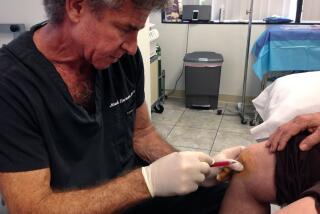California stem cell agency needs to study itself
For years, Geron Corp. had claimed to be in the vanguard among California companies engaged in stem cell research. So it was something of a stunner when it announced Nov. 14 that it was abandoning the stem cell field completely.
Geron’s shares fell 20% the next day, but that was probably nothing compared with how far spirits must have fallen at the California stem cell agency, which just a few months earlier had made its highest-profile investment ever by awarding Menlo Park-based Geron a $25-million loan to help fund the first human trial of stem cell-based spinal cord therapy.
Since the announcement, the agency has been doing its darndest to reassure everyone that Geron’s decampment isn’t a huge embarrassment.
Such unexpected glitches are bound to happen when you’re on the cutting edge of science, says the agency, which is known formally as the California Institute for Regenerative Medicine, or CIRM. “There are going to be fits and starts,” its chairman, Jonathan Thomas, told me last week. Even so, he maintained, “we remain unwavering in our commitment to pursuing the science.”
Agency officials point out that since Geron promptly refunded the $6.42 million it had drawn down from the CIRM loan, plus interest, this is a case of no-blood, no-foul. That’s an exceedingly tolerant view of the ramifications, however. CIRM’s approval of the loan last May had been preceded by what the agency says was “robust” peer review and proclaimed by the agency’s founder and then-chairman, Robert Klein, to be a “landmark step for CIRM.” In bailing out of the field, Geron halted a clinical trial that had already enrolled five patients.
So we’re talking at least about months of wasted effort by CIRM and Geron’s researchers, crushing disappointment for those patients and conceivably a major setback for stem cell science generally. Thomas observes that Geron said it made its decision strictly on financial grounds, not because of scientific reversals. But for an R&D company financial considerations always encompass scientific judgments, and Geron plainly concluded that the prospect for profits from stem cell therapies was receding.
The Geron fiasco underscores the old questions, and raises new ones, about what CIRM is supposed to accomplish, how it does business and whether its addiction to hype does a disservice to patients and taxpayers.
These questions are only going to become more important in the future, as CIRM prepares to ask California voters for new billions to supplement its original $3-billion bond issue authorized by voters through 2004’s Proposition 71, which established the agency.
CIRM loves to compare itself to the federal government’s biomedical research agency, the National Institutes of Health, but the two bodies are very different. The responsibilities of NIH are broad enough for it to make disinterested judgments about programs and scientific approaches. CIRM, however, was designed from the start (by Klein, who oversaw the drafting of Proposition 71) to focus on a very narrow field of biomedical science — embryonic stem cell research — and to promote that research in California as a sort of economic development tool.
These two goals have always been ethically and scientifically incompatible, and the Geron case points to why.
To begin with, there’s evidence that CIRM, anxious to show progress toward bringing stem cell therapies to market, downplayed legitimate questions about the state of Geron’s science and the design of the clinical trial. CIRM’s anxiety sprang from the Proposition 71 campaign itself, which snowed California voters with exaggerated promises of cures for conditions such as Alzheimer’s, Parkinson’s, diabetes and spinal cord paralysis.
The latter was Geron’s baby. The company last year won approval from the Food and Drug Administration to start injecting patients with cells derived from stem cells. This trial was a preliminary step toward showing that the process might help regenerate critically injured spinal tissue and end the subjects’ paralysis.
But Geron had been criticized in the past for over-promising results. Some researchers questioned the design of its clinical trial and even whether spinal cord injury was the best subject for the first tests of stem cell therapies on humans. Says Joan Samuelson, a Parkinson’s patient advocate who cast the sole dissenting vote on the CIRM board against the Geron loan: “I felt at the time that not all my questions had been answered about the readiness of that trial by that company.”
None of these issues were aired publicly in the run-up to the vote, because CIRM didn’t disclose in advance that Geron was the loan applicant. Nor did it disclose that its own scientific review panel had awarded the Geron trial a scientific score of only 66 out of 100; that fact, along with other details of the board’s consideration of the Geron loan, was pried out of CIRM later by David Jensen, the tireless proprietor of the indispensable California Stem Cell Report.
CIRM told Jensen that although it customarily discloses its reviewers’ scientific scoring of funding proposals, it didn’t in this case because it was using “new criteria” and thus the public might not find the result “meaningful.” Call me a cynic, but I’d bet that if the score were, say, 90 out of 100, CIRM would have shouted it from the rooftops, rather than pleading that Californians were too dumb to understand what the number meant.
It’s proper to ask whether Geron was the right partner for CIRM under any circumstances. The company has never recorded an annual profit since its founding in 1990. That’s not unusual among early-stage research firms, but Geron was also undergoing management turmoil. Its longtime chief executive, Thomas Okarma, a sedulous promoter of stem cell research, abruptly stepped down in February. The new CEO, John Scarlett, wasn’t hired until the end of September, five months after the CIRM loan was approved; six weeks later he pulled the plug on Geron’s stem cell efforts, saying that the company would henceforth concentrate on more promising cancer research.
CIRM learned about Geron’s move like the rest of the world — from the firm’s public announcement on Nov. 14.
Other aspects of the Geron deal should give Californians pause. For example, five of the CIRM board’s 28 members had to recuse themselves from the vote because of conflicts of interest. That underscores the structural weakness of the board, which is drawn almost entirely from patient advocacy groups and biomedical research institutions angling for grants.
“These conflicts of interest are built into the governing board” by Proposition 71, observes Marcy Darnovsky of the Oakland-based Center for Genetics and Society, a longtime CIRM critic. But Proposition 71 also makes it almost impossible to restructure the board.
Another problem illuminated by the Geron case is that CIRM remains infected by the hype virus. Only a week after Geron parachuted out of the stem cell business, Thomas issued a statement bemoaning the public impression that CIRM isn’t making any progress toward therapies. He declared: “CIRM is turning stem cells into cures.”
Well, no it isn’t, not yet. Geron’s now-halted project was the most advanced human clinical trial in CIRM’s portfolio; yet it was at an extremely early stage, involved all of five human subjects and might still have been years away from showing that a cure was even possible. CIRM needs to take a good look at whether it pushed too hard for the Geron loan and overplayed the significance of the trial; otherwise its path toward building credibility with the public will only get longer.
Michael Hiltzik’s column appears Sundays and Wednesdays. His latest book is “The New Deal: A Modern History.” Reach him at [email protected], read past columns at latimes.com/hiltzik, check out facebook.com/hiltzik and follow @latimeshiltzik on Twitter.
More to Read
Inside the business of entertainment
The Wide Shot brings you news, analysis and insights on everything from streaming wars to production — and what it all means for the future.
You may occasionally receive promotional content from the Los Angeles Times.











